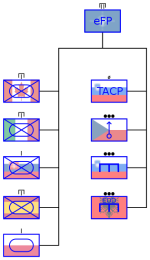Do we believe that large scale military conflict involving ground forces between the West and a peer opponent is likely? If so, do we see the requirement for Canada to be able to deploy AND SUSTAIN in high intensity conflict a full Division capable of independent action?
It's actually a two part question. The first part is: "Do we see that large scale military conflict involving ground forces between the west and a peer opponent is a
foreseeable possibility?" The second part is: "If we do, then
what force is needed to deter such a possibility?"
Likelihood has noting to do with the security posture adopted. It has everything to do with how much you prioritize resources for that eventuality. To me that's the difference between a full-time force and a part-time force. The more likely an event is, the more you have to be prepared to react quickly for it. The less likely an event is the more you can relegate the dedicated force structure to less expensive forces (such as a part-time force).
It becomes a matter of risk management. However, if an event is foreseeably possible, to risk manage the force to a zero capability will lose its value as a deterrent. This is exactly what Canada has done with so many vital capabilities.
If we don't believe that such a major land conflict requiring Divisional-sized forces is likely, or if we decide that we are comfortable with supplying the Brigade-sized building blocks to Allied forces in case of such a conflict then the way we chose to structure our forces is fundamentally different than if we do feel there is the need for a fully deployable Division.
If there is one thing that Ukraine is teaching us its that major land conflicts requiring divisional-sized forces is not only likely but probable.
I agree fully that at present we will not deploy a division but we're already talking about being the framework nation for a brigade assigned to a NATO multinational division. The reason we should be formed into at least one divisional structure is twofold. First, in order to have a viable brigade, you need to train your officers in the fundamentals of a divisional structure and the enablers brought to the table by a division and corps. In other words the brigade must train as a brigade that is part of a division. It needs to work out both its tactical and logistical doctrine and TTPs and have people who are instantly able to apply it/them. That requires a viable divisional framework at home to train within. Secondly, a prudent army would have a skeleton structure to build on in the event that more force is needed. Divisions have esoteric capabilities that do not exist within the brigade group. If those capabilities are risk-managed to zero-like air defence has been-then it becomes a years-long process to rebuild the expertise needed to run it effectively.
The napkin force that I've been playing around with is essentially a two phase one. Phase one creates divisional structures tailored to potential roles with the equipment and manning adjusted as to the likelihood of use. Less likelihood=more part-timers and just enough equipment to meet the training requirements; more likelihood=more full-timers and more equipment to meet low-notice missions.
Phase two merely builds on the existing structure by adding equipment. Should the risk level for employment of a heavy force rise then one merely adds equipment and increases the training tempo of the part-timers without the need to also develop the senior leadership skills needed and the doctrine from scratch.
Again, I'm not saying that we field a deployable division in the immediate future; I'm saying you need a deployable division structural framework in order to properly train deployable brigades and to give you a leg up when the possible need for a deployable division becomes a probability.
In my opinion if we're not willing to go "all in" on a deployable Division(s) then don't pretend. Invest in effective Brigade-sized building blocks that can plug into allied Divisions and put the money saved into the RCN and RCAF.
I'm not sure if anyone here has ever advocated going "all in" on a deployable division. I've gone so far as to say that we could form a deployable divisional headquarters and a deployable brigade both of which could be made sustainable for a short term of several years in peacetime and perhaps a year in wartime (using the Ukraine experience as a gauge) with the people and equipment we currently have. I'll go a step further, we could probably deploy a rump division of two brigades (missing all of its key enablers) out of the equipment and people we have but it would be an unsustainable, one-shot event.
I've also said it before. We're investing adequately in our navy and air force at this time. Our biggest problem is how we are seen by our allies and enemies and that focuses on the Army which is an expensive but toothless organization. It has no credibility with either allies or opponents. It needs to be seen as having value in order to provide the country with a measure of credibility and status for the wealth that it has. We already have and pay the Army for enough full-timers and part-timers to properly staff two real divisions. For a small investment in additional equipment (a small fraction of what we've already committed to the air force and navy) we could make that two equipped divisions.
No one here is arguing for a return to a cold-war army albeit that a modern army will, by necessity, still have cold-warlike elements to it. That's where the American structures help. They are expending a lot of brain power on that and we should watch it closely.






